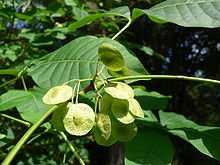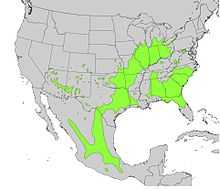Ptelea trifoliata
| Ptelea trifoliata | |
|---|---|
 | |
| Common hoptree fruit | |
| Scientific classification | |
| Kingdom: | Plantae |
| (unranked): | Angiosperms |
| (unranked): | Eudicots |
| (unranked): | Rosids |
| Order: | Sapindales |
| Family: | Rutaceae |
| Genus: | Ptelea |
| Species: | P. trifoliata |
| Binomial name | |
| Ptelea trifoliata L.[1] | |
 | |
| Natural range | |
Ptelea trifoliata (hoptree, stinking ash, wafer ash) is a species of flowering plant in the Rutaceae family, native to North and Central America. It is a deciduous shrub or tree,[2][3] growing to 8 m (26 ft) tall by 4 m (13 ft) wide.[4]
Taxonomy
Trifoliata refers to the three-parted compound leaf.[5]
Distribution
Ptelea trifoliata is the second-northernmost New World representative of the Rue (Citrus) family after American prickly-ash (Zanthoxylum americanum).[6][7]
While Ptelea trifoliata is most often treated as a single species with subspecies and/or varieties in different distribution ranges, some botanists treat the various Hoptrees as a group of four or more closely related species:[8]
- Common or Eastern Hoptree P. trifoliata (L.) ssp. trifoliata (Benth.); (P. trifoliata, sensu stricto) - eastern Canada & U.S., central U.S.[2]
- Common Hoptree P. trifoliata ssp. trifoliata var. mollis (Torr. & A. Gray) [8]
- Narrowleaf Hoptree P. trifoliata ssp. angustifolia (Benth.) (V. Bailey) var. angustifolia (Benth.) (M.E. Jones) (P. angustifolia, P. lutescens)
- Pallid Hoptree P. trifoliata (L.) ssp. polyadenia (Greene) - south-central and southwest U.S.[2][8]
- Pallid Hoptree P. trifoliata (L.) ssp. pallida (Greene) - southwest U.S.[2][8]
- Florida Hoptree P. trifoliata var. baldwinii (P. baldwinii)
Description
Ptelea trifoliata is a small tree, or often a shrub of a few spreading stems, 6–8 m (20–26 ft) tall with a broad crown. The plant has thick fleshy roots, flourishes in rich, rather moist soil. In the Mississippi embayment (Mississippi River Valley) it is found most frequently on rocky slopes as part of the undergrowth. Its juices are acrid and bitter and the bark possesses tonic properties.[5]
The twigs are slender to moderately stout, brown with deep U-shaped leaf scars, and with short, light brown, fuzzy buds. The leaves are alternate, 5–18 cm long, palmately compound with three (rarely five) leaflets, each leaflet 1–10 cm long, sparsely serrated or entire, shiny dark green above, paler below. The western and southwestern forms have smaller leaves (5–11 cm) than the eastern forms (10–18 cm), an adaptation to the drier climates there.
The flowers are small, 1–2 cm across, with 4-5 narrow, greenish white petals, produced in terminal, branched clusters in spring: some find the odor unpleasant but to others trifoliata has a delicious scent. The fruit is a round wafer-like papery samara, 2-2.5 cm across, light brown, maturing in summer. Seed vessel has a thin wing and is held on tree until high winds during early winter.[5]
The bark is reddish brown to gray brown, short horizontal lenticels, warty corky ridges, becoming slightly scaly, unpleasant odor and bitter taste. It has several Native American uses as a seasoning and as an herbal medicine for different ailments.[9]
- Bark: Dark reddish brown, smooth. Branchlets dark reddish brown, shining, covered with small excrescences. Bitter and ill-scented.
- Wood: Yellow brown; heavy, hard, close-grained, satiny. Sp. gr., 0.8319; weight of cu. ft., 51.84 lbs.
- Winter buds: Small, depressed, round, pale, covered with silvery hairs.
- Leaves: Alternate, compound, three-parted, dotted with oil glands. Leaflets sessile, ovate or oblong, three to five inches long, by two to three broad, pointed at base, entire or serrate, gradially pointed at apex. Feather-veined, midrib and primary veins prominent. They come out of the bud conduplicate, very downy, when full grown are dark green, shining above, paler green beneath. In autumn they turn a rusty yellow. Petioles stout, two and a half to three inches long, base enlarged. Stipules wanting.
- Flowers: May, June. Polygamomonoecious, greenish white. Fertile and sterile flowers produced together in terminal, spreading, compound cymes; the sterile being usually fewer, and falling after the anther cells mature. Pedicels downy.
- Calyx: Four or five-parted, downy, imbricate in the bud.
- Corolla: Petals four or five, white, downy, spreading, hypogynous, imbricate in bud.
- Stamens: Five, alternate with the petals, hypogynous, the psitillate flowers with rudimentary anters; filaments awl-shaped, more or less hairy; anthers ovate or cordate, two-celled, cells opening longitudinally.
- Pistils: Ovary superior, hairy, abortive in the staminate flowers, two to three-celled; style short; stigma two to three-lobed; ovules two in each cell.
- Fruit: Samara, orbicular, surrounded by a broad, many-veined reticulate membranous ring, two-seeded. Ripens in October and hangs in clusters until midwinter.[5]
Cultivation
Numerous cultivars have been developed for ornamental use in parks and gardens. The cultivar 'Aurea' with golden leaves has gained the Royal Horticultural Society's Award of Garden Merit.[10]
References
| Wikimedia Commons has media related to Ptelea trifoliata. |
- ↑ "Taxon: Ptelea trifoliata L.". Germplasm Resources Information Network. United States Department of Agriculture. 2001-11-13. Retrieved 2009-12-01.
- ↑ 2.0 2.1 2.2 2.3 2.4 USDA - Ptelea trifoliata (common hoptree) . accessed 8.24.2011
- ↑ ITIS Standard Report Page: Ptelea trifoliata . accessed 8.24.2011
- ↑ RHS A-Z encyclopedia of garden plants. United Kingdom: Dorling Kindersley. 2008. p. 1136. ISBN 1405332964.
- ↑ 5.0 5.1 5.2 5.3 Keeler, Harriet L. (1900). Our Native Trees and How to Identify Them. New York: Charles Scriber's Sons. pp. 32–35.
- ↑ Lady Bird Johnson Center @ wildflower.org . accessed 8.24.2011
- ↑
- ↑ 8.0 8.1 8.2 8.3 8.4 USDA PLANTS: P. trifoliata Classification . accessed 8.24.2011
- ↑ University of Michigan - Dearborn: Native American Ethnobotany, species account. . accessed 8.24.2011
- ↑ "RHS Plant Selector - Ptelea trifoliata 'Aurea'". Retrieved 27 June 2013.
 "Hop tree". Collier's New Encyclopedia. 1921.
"Hop tree". Collier's New Encyclopedia. 1921.